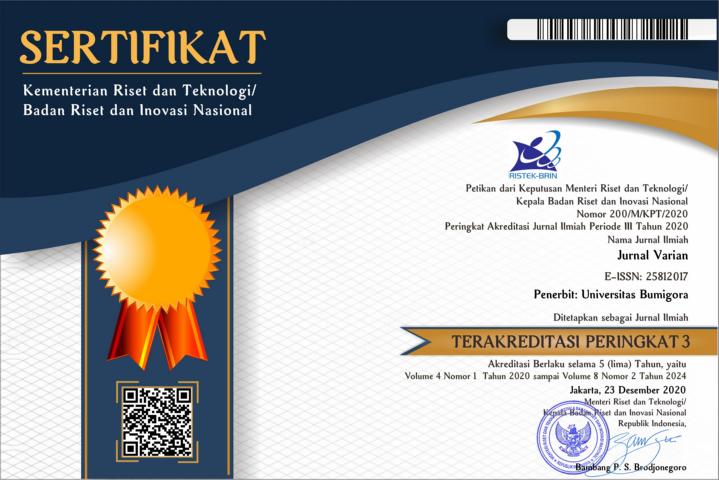Mathematical Modelling of Deforestation Due to Population Density and Industrialization
Abstract
The focus of the study in this paper is to model deforestation due to population density and industrialization. To begin with, it is formulated into a mathematical modelling which is a system of non-linear differential equations. Then, analyze the stability of the system based on the Routh-Hurwitz stability criteria. Furthermore, a numerical simulation is performed to determine the shift of a system. The results of the analysis to shown that there are seven non-negative equilibrium points, which in general consist equilibrium point of disturbance-free and equilibrium points of disturbances. Equilibrium point TE7(x, y, z) analyzed to shown asymptotically stable conditions based on the Routh-Hurwitz stability criteria. The numerical simulation results show that if the stability conditions of a system have been met, the system movement always occurs around the equilibrium point.
References
Journal of Mathematics and Computer Research, 4(1):1–15.
Anggriani, I., Nurhayati, S., and Subchan, S. (2018). Analisis Kestabilan Model Penurunan Sumber Daya Hutan Akibat Industri.
Limits: Journal of Mathematics and Its Applications, 15(1):31–40.
Arfan, A., Maru, R., Side, S., Abidin, M. R., and Sideng, U. (2021). Mangrove Forest Management Strategy As A Sustainable
Production Forest Area in Luwu District, South Sulawesi Province, Indonesia. In Journal of Physics: Conference Series, page
012089.
Austin, K. G., Schwantes, A., Gu, Y., and Kasibhatla, P. S. (2019). What Causes Deforestation in Indonesia? Environmental
Research Letters, 14(2):024007.
Didiharyono, D. (2016). Stability Analysis of One Prey Two Predator Model with Holling Type III Functional Response and
Harvesting. Journal of Math Sciences, 1(2):50–54.
Didiharyono, D. and Irwan, M. (2019). Analisis Kestabilan dan Usaha Pemanenan Model Predator Prey Tipe Holling III dengan
Keuntungan Maksimum. Jurnal Varian, 2(2):55–61.
Dubey, B. and Narayanan, A. S. (2010). Modelling Effects of Industrialization, Population and Pollution on a Renewable Resource.
Nonlinear Analysis: Real World Applications, 11(4):2833–2848.
Dubey, B., Sharma, S., Sinha, P., and Shukla, J. B. (2009). Modelling The Depletion of Forestry Resources By Population and
Population Pressure Augmented Industrialization. Applied Mathematical Modelling, 33(7):3002–3014.
Ferraro, P. J. and Simorangkir, R. (2020). Conditional Cash Transfers to Alleviate Poverty also Reduced Deforestation in Indonesia.
Science Advances, 6(24):1–8.
Giarno, G., Didiharyono, D., Fisu, A. A., and Mattingaragau, A. (2020). Influence Rainy and Dry Season to Daily Rainfall
Interpolation in Complex Terrain of Sulawesi. In IOP Conference Series: Earth and Environmental Science, page 012003.
Kartodihardjo, H. (2017). Dibalik Krisis Ekosistem: Pemikiran Tentang Kehutanan dan Lingkungan Hidup.
Misra, A. K., Lata, K., and Shukla, J. B. (2014). A Mathematical Model for The Depletion of Forestry Resources Due to Population
and Population Pressure Augmented Industrialization. International Journal of Modeling, Simulation, and Scientific Computing,
5(01):1350022.
Qureshi, S. and Yusuf, A. (2019). Mathematical Modeling for The Impacts of Deforestation on Wildlife Species Using Caputo
Differential Operator. Chaos, Solitons & Fractals, 126(1):32–40.
Ramdhani, V., Jaharuddin, J., and Nugrahani, E. H. (2015). Dynamical System of Modelling The Depletion of Forestry Resources
Due to Crowding By Industrialization. Appl. Math. Sci,, 9(82):4067–4079.
Sebastian, E. and Victor, P. (2017). Modelling Deforestation Due to Human Population and Its Effect on Farm Fields. Journal of
Informatics and Mathematical Sciences, 9(3):903–913.
Suci, N. and Arnellis, A. (2014). Model Matematika Kerusakan Sumber Daya Hutan di Indonesia. UNP Journal of Mathematics,
1(1):1–6.
Sundar, S., Swaroop, N., and Naresh, R. (2017). Modeling The Effect of Population and Population Augmented Industrialization
on Forestry Resources. European Journal of Engineering Research and Science, 2(1):65–70.
Talumepa, J. B. (2020). Kajian Hukum Terhadap Tata Kelola Hutan di Indonesia. Lex Et Societatis, 8(4):25–35.
Teru, A. H. and Koya, P. R. (2020). Mathematical Modelling of Deforestation of Forested Area Due to Lack of Awareness of Human
Population and Its Conservation. Mathematical Modelling and Applications, 5(2):94.
Toaha, S. (2013). Pemodelan Matematika dalam Dinamika Populasi.
Toaha, S. and Rustam, R. (2017). Optimal Harvesting Policy of Predator-Prey Model with Free Fishing and Reserve Zones. In AIP
Conference Proceedings, page 020023.
Wang, J., Chagnon, F. J., Williams, E. R., Betts, A. K., Renno, N. O., Machado, L. A., ..., and Bras, R. L. (2009). Impact of
Deforestation in The Amazon Basin on Cloud Climatology. Proceedings of the National Academy of Sciences, 106(10):3670–
3674.
Yumna, Y. and Halid, I. (2015). Special Analysis for Predicting Changes In Mangrove Forest. International Journal of Scientific &
Technology Research, 4(1):144–147.
Zhang, M. and Wei, X. (2021). Deforestation, Forestation, and Water Supply. Science,, 371(6533):990–991.

This work is licensed under a Creative Commons Attribution 4.0 International License.


















